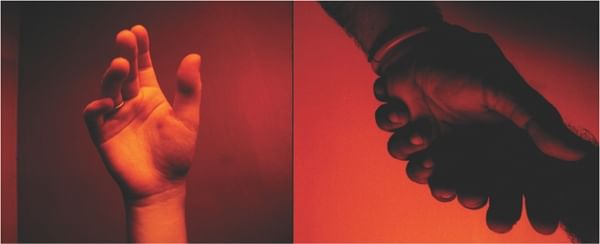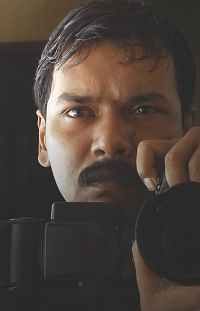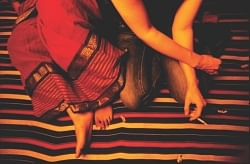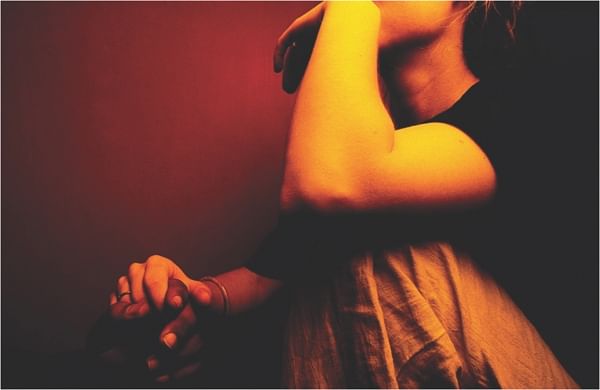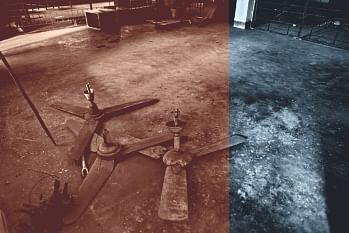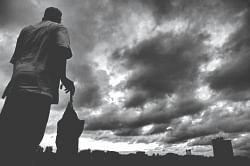| Home - Back Issues - The Team - Contact Us |
 |
| Volume 10 |Issue 43 | November 18, 2011 | |
|
|
Profile
Mixing Hopes and Horizons Fayza Haq
Sitting in the backyard of Alliance Française, surrounded by its white-painted wrought iron furniture, with the city's traffic noises booming behind us two, Imtiaz Alam Beg of Begart, says, “It was my father's photos that inspired me from the onset as a child. His name, as all know him by, was MA Beg. 80 percent of professional photographers of Bangladesh were his students at the Begart Institute.” He was speaking about his profession, which is also his passion. Asked to dwell on eminent photographers, Beg says, “Among these photographers, one my favourites is Anwar Hussain, whose solo exhibition was recently held at Dhaka Art Centre. Anwar Hussain's work has been often seen in the city. His one but last exhibition was at Alliance Française, as I can recall. I admire him for the way he has depicted the struggle of the ordinary people of Bangladesh. He has dealt with the pictorial element of photos in a superb manner. His photos are aesthetic and picturesque. There is a cinematic element behind each of his photos. His earlier works, based on Old Dhaka, were like the open palm with the five fingers—outstretched, the old, aging lock on the ancient door. He has an entire book titled “Women” and this is very good. There are others–such as Bijen Sarkar– who are also remarkably good.
“There are other photographers too to inspire me and impress me greatly like Dr Rashidun Nabi Shubhro, who is a physician by profession, and lives in Rd 19, Dhanmondi. Some of his pictorial art works of Bangladesh are unforgettable. Dr Noazish Ahmed, with his “Chinno Potro”, is one of our pioneer photographers. He is known for the work he did on trees, flowers and leaves. Rashid Talukdar, who died recently, was also a remarkable photojournalist, who took memorable pictures, putting his life at risk. These were of the 1969 struggle – being pre-revolution– recording the struggle of the Bengali nation against the Pakistan oppression. He happened to be a family friend, and this gave me the opportunity to follow him about his assignments, and learn from him. His daring work, risking his life, was unparalleled during that time. His pictures on the Liberation War are simply countless. He presented the positive aspects of Bangladesh, rather than the negative, which has become the run of the mill of the NGO-based photographers – who use the pictures to draw funds from overseas. We may not be rich, material-wise, but the dauntless and the courage to struggle within us is something the world should see and marvel at. Our natural beauty alone should not be noted and admired.
“Raghu Rai, from India, is among my favourites. I think he is a pioneer photographer. Among his famous works are that based on Tajmahal. This is centred on the rich and poor living around the famous Moghul monument. Ragu Rai has also captured the Bhopal radiation catastrophe extremely well. His book “Bhopal” records the suffering of the people. His books on Kolkata and Mother Teresa are also nonpareil. He focused on Kolkata, as this was one of the ancient cities of India. What is remarkable is that even though he captures panoramic scenes, there is nothing that is out of focus. There are many layers of meaning to his photography. His subject is the common man and his journey through the passage of time. People of different origins are brought into the focus. There are individuals with varied characteristics that come on his stage of life. There are many people doing many things in his pictures. This is the beauty of Raghu Rai's pictures. Rags and riches coexist in harmony. I would say that his style of that of Henri Cartier-Bresson, one of the most powerful photographers. A major work of his is one that captures characters of the sixties, ranging from famous politicians and singers like JF Kennedy to the Beatles, Janice Joplin, Bob Dylan, criminals and even a snake charmer. He belied that the liveliest part of the twentieth century was the sixties. In an interview to the media he'd said that he'd not seen such powerful people in any other time. He felt that if one were to consider creativity alone, the most vibrant people that he knew belonged to the sixties. Most of his work was in black and white. His philosophy was that the world needed a change at that time, and these people bring the necessary change. Another individual, who is close to my heart, is Richard Abedin, from the US, who died recently; and Arnold Newman.”
Asked to dwell on the latest subject of the focus of his lens, Imtiaz says that it was the urban class. He says that he is not interested in panning the camera on to the poor in Bangladesh. He says he has many reasons for this; one being that the poor in Bangladesh is a subject that is overexposed. This is a source of means of the NGOs. He wants to portray the changes time has brought into Dhaka. The 1990s has many interesting stories to tell, that should be recorded for all times, says Imtiaz. “There have been many changes in technology,” he says. He wishes to depict the attitude of the urban class. Apart from this he has a portfolio on puppets, but this remains incomplete, to date. Apart from photography, 41-year-old Beg is interested in animal welfare. For many reasons, the animal world is helpless and neglected, he feels; and he believes that people must be made aware of this. He says that for his stock photography, he has to travel outside Dhaka often. This, he says, is to provide pictures on subjects like Kantojir Mandir or Rajshahis's Shona Masjid for advertising purposes etc. These pictures are for calendar companies and billboards. He says that photography is a powerful media, and has a language of its own. Through this we convey expressions and attitudes. It is one of the most powerful and quickest means of communication, he says. “All said and done, it is a form of art,” he adds. After his father died in 1998, Imtiaz Alam Beg is running the Begart Institute. At Begart Institute, there is regular training of photographers, says Beg. One is a basic course of a month. The next one is a diploma course of a year, for professionals. These courses have been running since 1960. His father studied photography in Europe, England and Germany. Imtiaz Alam Beg began photography in 1985, when he was a student at school. He began his professional life in 1991. At first he focused on Bangladeshi bands. By the time he was twenty, the pioneer musical band covers were done by him. These were done in both black and white and colour. During these years some of his pictures won awards, including gold medals. His photos were exhibited at Luxemburg and Netherlands. In 1996, at a workshop in Delhi, arranged by India International Photographic Council in which there were 40 participants from all over the world, he represented Bangladesh along with ten others. At that time began his regular work for the largest advertising firms in Bangladesh, such as “Mediacom”, “Interspeed”, “Bitopi” and “Asiatic.
Copyright
(R) thedailystar.net 2011 |
